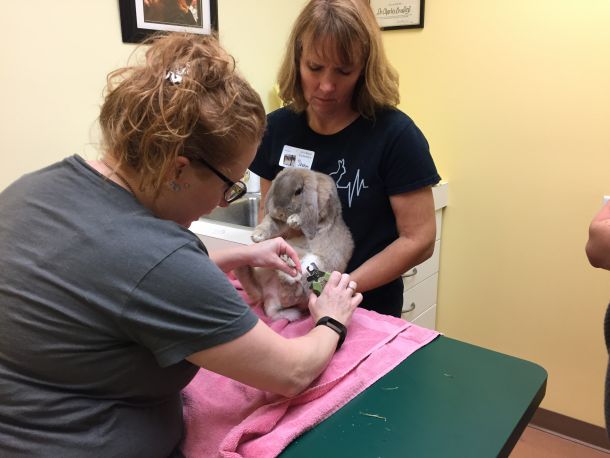
Photo courtesy of House Rabbit Network, Sara Christensen
Q: Tell us about the work you do at House Rabbit Network and your overall mission.
ST: The House Rabbit Network has two main missions. Our primary mission is to take in displaced rabbits and find them good, indoor homes. We spay/neuter, assess personality, provide medical care, and work on litter box training. Last year we had a record 430 adoptions.
We believe that education will help reduce the pet over population problem so we strive to educate the public about rabbits and their care. It is important we get out the word that rescues exist. For rabbits (or any pet) you should learn as much as you can first to determine if they are a good fit for you. We also help current rabbit owners answering questions about behavioral issues, housing and care. On our website we have over 80 articles on rabbit behavior, health and care. We answer questions and chat with people on the phone, via email and on social media.
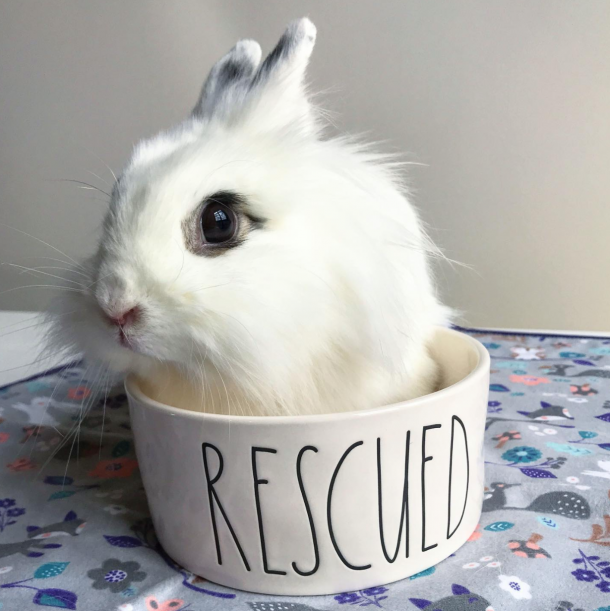
Photo courtesy of House Rabbit Network, Paula Santos
Q: How prevalent is the issue of homeless domesticated rabbits? What are some of the reasons behind it?
ST: Rabbits are the third most surrendered pet after dogs and cats.
Rabbits also are notoriously hard to sex and there is a reason they say “breed like rabbits”. People often get two rabbits from a pet store or breeder, thinking they are the same sex. A female rabbit can get pregnant as young as 3.5 months old. Gestation period is 28 days so she can be giving birth at 4.5 months old. There is a large range of litter sizes but often there are 6-8 kits. Then add to this they are induced ovulators which means as soon as mom gives birth, she can get pregnant again. When some families find the first litter mom is already pregnant with the second, which means at 5.5 months old she has already had two litters . You cannot sex baby rabbits until they are almost two months old. And if they don’t properly sex and separate the babies by the time they are 3 months old, then you have the babies having babies (siblings easily mate with each other). It quickly gets out of control. Several times a year we are asked to assist with rescues of 20+ rabbits.
Some parents think a rabbit is a good starter pet for their child. Rabbits are a fair amount of work, need daily feedings, cleanings, attention and play time. Many kids tire of caring for the pet and then the parent thinks they will teach their child a lesson by getting rid of the rabbit, when what they are really teaching them is pets are disposable. You would never sign your child up for 8 years of soccer, karate or piano, why sign your child up for years of caring for a bunny?
Easter. Too many parents think baby bunnies make an adorable Easter gift without thinking it through. How long will your child be excited about having a live bunny? A week? Two weeks? And then what happens to the bunny? What happens to the bunny when the novelty wears off?
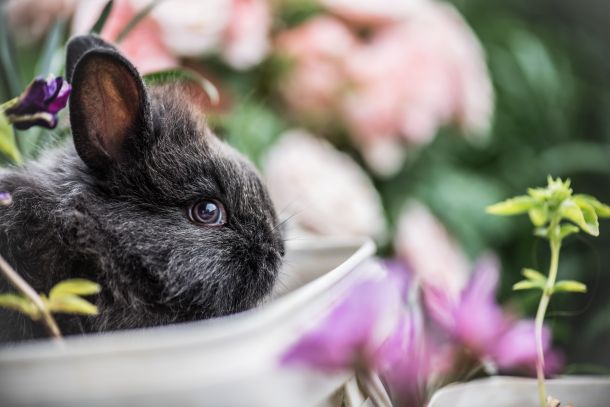
Photo by Diana Măceşanu on Unsplash
Q: What’s a day in the life of a rabbit shelter worker?
ST: It really depends on what the person’s responsibilities are. For those that strictly take care of the bunnies, it involves feeding them breakfast in the morning. Next they check that they still have plenty of hay and water. After breakfast volunteers set up pens where the bunnies can take turns getting exercise, running and playing for a couple of hours. (they cannot play together, they take turns in the pen). While the rabbits are out playing, their cages are cleaned. Litter boxes are emptied and refilled with wood stove pellets and hay, cage floor swept. We have 3 different shifts, the night shift will give them greens for dinner, change their water bottles, and make sure they have plenty of hay.
Working/volunteering at a shelter involves a lot more than just caring for the rabbits and you cannot really choose any one activity and say it is typical. We have our adoption counselors that handle adoption requests. They go over rabbit care with potential homes helping them determine if a rabbit is right for them. We have volunteers that schedule adoption appointments where they introduce prospective homes to the bunnies at the shelter and see if there is a match. Then there are the routine tasks- data entry for all our rabbits, taking pictures for the web site, writing descriptions of the bunnies, posting on social media, coordinating spay/neuter surgeries, handling intakes and coordinating foster homes, sending out teams to capture stray (not wild) rabbits, bookkeeping and paying our bills, web site management and more.
We have volunteers that work on events and fundraisers- we have “Bunny Spa Days” where you can bring in your rabbit to our event. They get their nails trimmed, scent glands cleaned, a brush out, a massage and a photo session. Volunteers are at each station doing different tasks, others handling checkins, and even coordinating the events in advance. We have dinner benefits and online auctions, all of which need volunteers to run them.
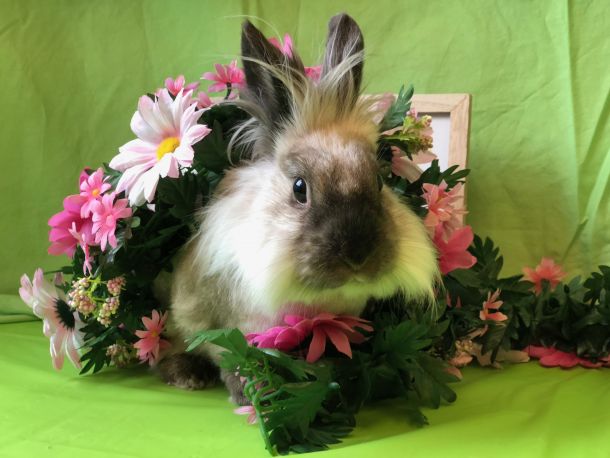
Photo courtesy of House Rabbit Network, Sara Christensen
Q: What should prospective rabbit owners think about and prepare for before getting a pet rabbit?
ST: Learn as much as you can first so you can make an informed decision if a rabbit is the right pet for you. Some things to consider are:
The average lifespan is 7-10 years but some can live to 12 or even older.
They need daily exercise and play time outside of their cages. They are smart animals that need stimulation.
Each rabbits is unique, they all have different personalities. Some are confident and outgoing while others are shy. They can be playful, inquisitive, some jump, others do not. There are couch potato bunnies and also rabbits so busy exploring the world they don’t want to sit still.
They need vet care. You also need to find a vet that specializes in rabbits and when they get sick it can be more expensive. It is important to spay or neuter your rabbit, even if you have a single bunny. Female rabbits have a high rate of uterine cancer, over 50% by the time they are 5 years old. Male rabbits can spray.
Hay, hay and more hay. Hay is the most important thing for rabbits to eat and they need to have unlimited access to it.
Rabbits like to chew! You will need to rabbit proof the section of your home where they will live. Hide cords, protect wood. They will find small spaces to squeeze into.
Rabbits should live indoors. When they live outdoors they are at risk for attack from predators, getting fly strike, heat stroke in the summer, freezing in the winter or even being stolen. Plus being prey animals you will be more in tune to picking up if something is wrong if you are interacting with them on a regular basis.
Most rabbits do not like to be held. Many like attention and pets, but with their feet on the ground.
Kids should be taught to never pick up a rabbit. They have a fragile bone structure and if dropped can easily break a leg or their spine.
Most fixed rabbits can learn to use a litter box. They typically are very good with their urine and get most poop in the box too.
When you consider how expensive it is to spay or neuter a rabbit on your own, paying adoption fees and getting a rabbit from a rescue is a lot less expensive.
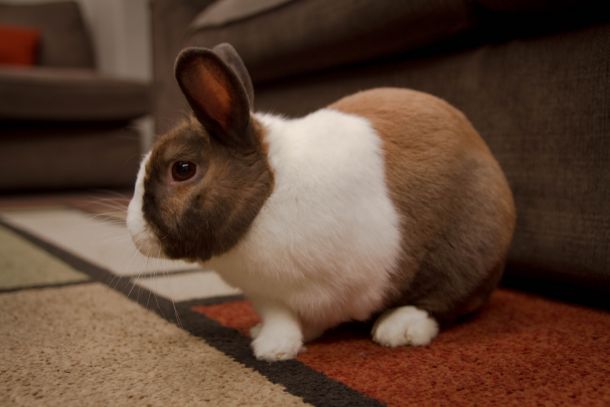
Photo by NeONBRAND on Unsplash
Q: How can people better support rabbit rescue efforts?
ST: Spread the word that we exist! A surprising number of people know there is rescue for dogs and cats but many do not know there are rescues (and pets that need rescue) for rabbits, guinea pigs, ferrets, birds and more.
When you are looking for a pet, please adopt! Whether you choose a bunny from us or another rescue the most important thing to us is you adopt a rabbit in need. There are so many wonderful rabbits out there looking for homes. There are also advantages to adoption in that you can get an already fixed rabbit, and a knowledgeable shelter will know the personalities of their pets and can help you make the best match.
Spay and neuter! If you get young rabbits please take them to a vet to be sexed and get them fixed as soon as they are old enough. Not only will you prevent unwanted litters, but it improves litter box habits and makes for calmer pets. Female rabbits have a greater than 50% chance of developing uterine cancer by the time they are 5 years old so it is very important to spay for health reasons too, even if you have a single rabbit. Male rabbits can spray and sometimes exhibit other naughty behaviors.
Donate. Running a rescue is not cheap! We spend a lot money (well more than half our budget) on spays, neuters and medical costs. You can always make a donation of cash, product (shelter food & supplies) or support fundraisers. Many groups have different types of fundraisers including parties, bunny spa days, dinner benefits, cuddle baby bunnies events and more. You will not only help the rescue but meet many other nice and like-minded friends.
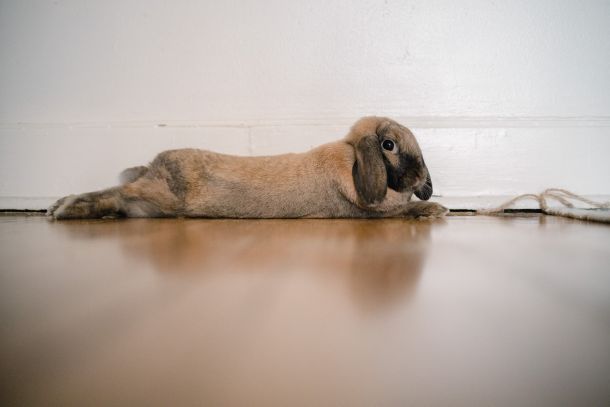
Photo by Shannon Litt on Unsplash
Q: Anything else you’d like people to know?
ST: Most rabbits are happier with a mate. Once they are fixed you can go through a dating process and gradually introduce bunnies over a couple of weeks. They enjoy the companionship of another rabbit, will play together and even teach each other things. Not to mention watching two rabbits sleep and snuggle together just melts your heart. So cute. Many rescue groups have bonded pairs so you can save two lives at once. Plus a bonded pair only uses one living area.
There is a large and well-connected rabbit community online. Search for local groups in your area. It is a great way to meet new friends and share your love for rabbits. Get connected! Groups work well together and support each other. For example if there is a large rescue, rescue groups across the country will take in some of the rabbits to help ease the burden. There is the “bunderground railroad” to help move rabbits across the country.
Rabbits can make wonderful family pets. They can learn several words, teach each other things, and can be happy when they are naughty. They really do work their way into your heart.
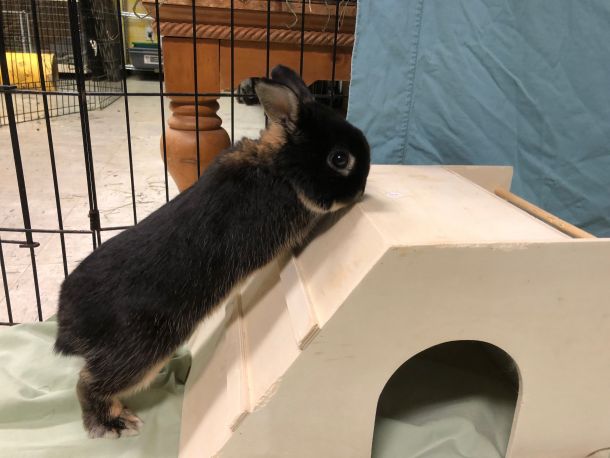
Photo courtesy of House Rabbit Network, Sara Christensen
Q: What are some additional resources where people can learn more about rabbit rescue?
ST: Please visit our website www.rabbitnetwork.org. We have over 80 articles on rabbit care along with listings of available rabbits. More resources are available on the House Rabbit Society web site, rabbit.org.
For adoption you can check with your local rescue group, petfinder.com and adoptapet.com.
Suzanne Trayhan is the President, Board of Directors and one of the original founders of the House Rabbit Network. Her contributions to the organization include handling medical cases, running fund raisers, assisting with the newsletter, the website and, of course, fostering rabbits. Suzanne lives with her four rabbits Cadbury, Calvin, Holly and Oscar and her husband Gary.
